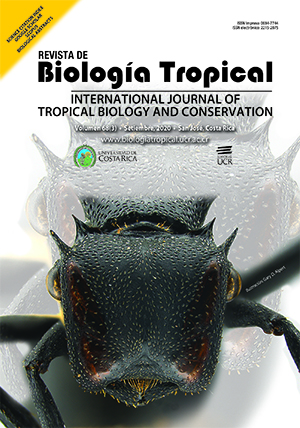Resumen
Abstract. Structure of the high Andean forest and paramo in the Bijagual Massif, Boyacá, Colombia. Introduction: Colombia has increased research due to the necessity of knowing the country´s biodiversity and ecosystems, as well as to establish priorities for their protection throughout the national territory. The knowledge of the Boyacá ecosystems and the high Andes are not an exception. Objective: this work provides information on diversity and structure of the Bijagual Massif, a high mountain area defined as a biological corridor, with paramo (2 900 - 3 460 masl) and high Andean forest (2 682 -3 268 masl) ecosystems. Methods: Sampling consisted of 27 random transects in the high Andean forest (100 x 2.5 m) and 13 in the paramo (10 x 5 m). We recorded abundance data, growth form, height, coverage, DAP and basal area. We calculated diversity analyses (H’, D and Jaccard), of vertical and horizontal structure. Results: Estimated species richness of 429 species in 86 families. Similarity does not exceed 46 % between sampling units, data that supports the heterogeneity of the Bijagual Massif. We recorded 10 777 individuals in the forest. The most abundant and richest growth forms were herbs (2 595/104) and trees (2 189/67), while lower in abundance and richness were vines (466/29). In the paramo 3 337 individuals, with a dominance of herbs (in frailejonal, shrubs and pajonal), rosettes (in frailejonal and pajonal) and shrubs. Species with ecological representativeness are: Clusia multiflora, C. elliptica, C. alata, Weinmannia rollottii, Brunellia comocladifolia and Viburnum triphyllum. Conclusion: These results confirm the uniqueness of these high mountain ecosystems and the need to maintain the heterogeneity before the occurence of soil transformation processes. The last, is supported by the high species turnover among sampling units, the dominance per physiognomic type, and the ecological significance of arboreal and shrub species in the forest and those that reoccur in the paramo. Here we define Bijagual, as a biological corridor with great biodiversity.
Comentarios

Esta obra está bajo una licencia internacional Creative Commons Atribución 4.0.
Derechos de autor 2020 Pablo Andrés Gil Leguizamón







